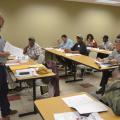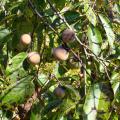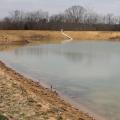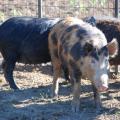News By Department: Wildlife, Fisheries & Aquaculture
STARKVILLE, Miss. -- Researchers at the Mississippi State University Deer Lab have one simple answer to almost every question land managers ask: Nutrition.
How do you improve the health of a deer herd? How do you attract more deer? How do you grow bigger bucks or larger racks? Improve nutrition, and most everything else will take care of itself.
STARKVILLE, Miss. -- Flowers are blooming, hardwood trees are budding and flowering, songbirds are singing, and wild turkeys are mating. Mississippi has to be the prettiest place on Earth, especially in the springtime, making it my favorite time of year.
Mississippi’s wild turkeys are majestic game birds that have always been important to people in the South. The earliest North Americans probably used the turkey as food. Since that time, the turkey has held an important niche in our economy and in the environment.
Agricultural clients met with Mississippi State University personnel to discuss research and education needs during the annual Producer Advisory Council Meeting for the southwest region February 20.
STARKVILLE, Miss. -- Shock. Disbelief. Denial. Anger. Acceptance. Get busy. This pretty much sums up my range of emotions after the Mississippi Department of Wildlife, Fisheries and Parks released a statement that a 4-year-old buck tested positive for chronic wasting disease, or CWD, in Issaquena County last week.
STARKVILLE, Miss. -- Deer season is over, and prescribed fire, timber management, planting food plots and other habitat improvements come later in the year, but one activity that's perfect for February and early March is planting trees.
STARKVILLE, Miss. -- Terms like climate change or global warming may elicit different responses depending on your political viewpoints, but one thing is certain: Our weather is changing.
ROLLING FORK, Miss. -- The Mississippi State University Extension Service invites producers, landowners and professionals in the Delta to a Cover Crop Field Day Jan. 19.
Wild hogs cost Mississippians millions of dollars each year, but landowners stand to lose more than money if the nuisance animals’ range and population continue to grow.
Left unchecked, wild hogs have the potential to steal property owners’ investments and cripple the state’s ecosystem in the process.
RAYMOND, Miss. -- Wild pigs have roamed parts of the Southeast since Spanish explorer Hernando de Soto introduced them as food for early settlers in the 16th century. But during the last two decades, Mississippi has experienced a rapid uptick in the spread of the nuisance animal.
Pages
- « first
- ‹ previous
- 1
- 2
- 3
- 4





